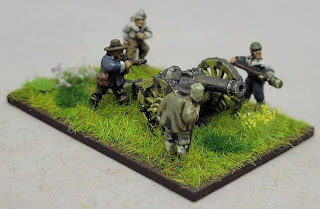Cannons for the Catholic Confederacy
The seventeenth-century siege was 'an affair of artillery', but the Irish had no proper artillery
Raw Generals and Green Soldiers, Catholic Armies in Ireland 1641-1643
Padraig Lenihan
The above quote sums up the state of the Irish Confederate artillery train rather succinctly; plus, it also explains why they didn't fare particularly well in a war of sieges.
 |
| Demi-culverin |
Clearly the Irish had some guns, but what did they have and how many? Details are scant.
The Irish did not have expertise in gun-founding, just two gun foundries existed in Ireland and they were in the Anglo Scottish settler communities: Boyle's foundry at Cappoquin and Blacknall's at Ballinakill.
Irish attempts at artillery manufacturing did not go well: Viscount Clanmalier had a tin cannon made that simply did not work; the leather cannon used at Ballyalla was even worse as it effectively blew up. They fared much better making fake cannons: a wooden cannon helped Daniel O'Dunne capture Caslecuffe. The fake gun was pulled into position by eight oxen, the defenders surrendering at the sight of it.
If they wanted any real volume of ordinance they had to import it. We know that the Irish had an agent at the Court of Spain, James Talbot bought siege guns and mortars.
Remembering that England had been systematically asset stripping Ireland since Tudor times, many Irish men had sought their fortune in Europe fighting for the Catholic cause. So it doesn't really take that much of a leap of faith to imagine that there were probably a number of men who had experienced, or were skilled in firing ordinance.
The Lords Justices complained that the culverin had to fire too many shots to create a breach in walls. Remember that early in the Wars, the Irish were very short of powder, and what powder they had access to was very expensive. Was the Lord Justices' comment led by accountants? Sounds like it might have been.
Gunners and military men deemed the culverin a 'good battering gun'. The biggest problem with a culverin, apart from accountants bemoaning the cost of powder, was that they needed good roads to move around due to their weight. Glenn Price (Soldiers and Civilians, Transports and Provisions) argues that a significant hindrance to the Scots armies manoeuvring in Scotland, was the quality of the roads - their baggage and supplies had to be carried on pack horses rather than carts in the main part, roads were impassable to carts. A similar situation existed in Ireland, roads were poor, and what main roads there were, were impassable to heavy loads except in summer.
The demi-culverin was a compromise between manoeuvrability and raw power. So that's a demi-culverin for my Irish army.
There are a handful of references to the Irish having field pieces: Gerat Barry carelessly losing his guns at Liscarroll to Sir Charles Vavasour. Whilst I would like a couple of drakes, Naismith limbers* are out of production, so I'll have to settle for a saker.
Guns and figures are, as always by Peter Pig, with a few headswaps. Bearing in mind men returning from Europe, and gunnery being a skilled profession, I'm quite happy with the Anglo European style of dress rather than Irish trews. I've even remembered to drill out the gun barrels.
Colour scheme, a little more colourful than my Irish foot, but still with a heavy nod to Sir J T Gilbert's (History of the Irish Confederation and the War In Ireland 1641-1643) description of the Confederates fighting at Kilrush being almost indistinguishable from the bog due to the dark colours they wore.
Limbers are from Museum Miniatures (all my medium and heavy artillery pieces have four horse team Museum limbers; lighter guns have two horse team limbers from Naismith). A headswapped dragoon horseholder acting as a drover.
My custom casualty markers from Warbases rounding things off.
* if the Naismith range ever becomes available again, I will be placing a large order for limbers, just in case...
If you enjoyed reading this, or any of the other posts, please consider supporting the blog.
Thanks.













Lovely jubbly! The Spanish sourced guns landed at Dungarvan, in April 1643, apparently consisted of two (or four) demi-cannon and a mortar. And there is some suggestion of Spanish culverins being landed elsewhere in the same period. But yes, agree, there is an dearth of evidence of field artillery of any kind being routinely used by the Confederates.
ReplyDeleteThanks Dex. The landing of the Spanish guns had an element of luck about it (if my memory serves me correctly), a lull in the fighting and perfect timing allowed them to be put straight to work.
Delete